|
|
|
Sort Order |
|
|
|
Items / Page
|
|
|
|
|
|
|
| Srl | Item |
| 1 |
ID:
183020
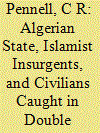

|
|
|
|
|
| Summary/Abstract |
During the Algerian Civil War of the 1990s responsibility for both targeted assassinations of prominent politicians and political activists and largescale massacres was frequently ascribed to both the government and the Islamic insurgents of the GIA. The same was true of the more mundane but much more numerous level of individuals who fell foul of both sides in the conflict and were frequently the targets of both. Using material from the asylum tribunals of several western countries this article describes how the widespread fear among the Algerian population was the result of the strategies of the government and GIA that both sought to intimidate, punish and exact revenge at a personal level leading to a widespread social dislocation.
|
|
|
|
|
|
|
|
|
|
|
|
|
|
|
|
| 2 |
ID:
183018
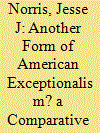

|
|
|
|
|
| Summary/Abstract |
Sting operations can potentially thwart terrorist plots, but could also threaten civil liberties and alienate communities, making them a critical subject for counterterrorism research. Yet despite considerable research on U.S. cases, little is known about terrorism stings elsewhere. How common are such cases abroad, and how many feature strong entrapment claims or result in entrapment-related acquittals? In this study, data are gathered about non-U.S. terrorism stings, each of which is evaluated for entrapment indicators. Results show that, contrary to claims of American exceptionalism, terrorism stings could be identified in twenty-one countries, and the average number of entrapment indicators per case is similar between the U.S. and several countries. In addition, several non-U.S. cases present entrapment claims as strong as some of the most-criticized U.S. cases. However, relatively few non-U.S. terrorism stings (fifty-one) could be identified, while there are 156 U.S. cases. In addition, unlike in the U.S., courts have acquitted defendants on entrapment grounds in a high proportion of non-U.S. cases. Political, cultural, and legal differences between the U.S. and other countries, and certain cross-national commonalities, are identified as likely accounting for these results. Potential implications of these findings for terrorism prevention and legal reform are considered.
|
|
|
|
|
|
|
|
|
|
|
|
|
|
|
|
| 3 |
ID:
183023
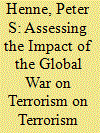

|
|
|
|
|
| Summary/Abstract |
After the 9/11 terrorist attacks, the United States called on Muslims to join it in its struggle against the attacks’ perpetrator, Al Qaeda (AQ). U.S. officials argued that Muslim states’ participation in these efforts could help the United States defeat AQ, but it could also benefit the states themselves by undermining the threat they faced from terrorism. As we are now over ten years out from the beginning of this global war on terrorism, it is possible to both ask and answer the question posed by U.S. demands: did it work? That is, did majority-Muslim states who implemented counterterrorism policies in line with America’s counterterrorism priorities benefit from this, through a reduction in the threat of terrorism? In this article, I argue that Muslim states that adopted policies in line with US priorities would accomplish their primary goal: disrupting Al Qaeda’s ability to carry out attacks. I use a quantitative analysis to demonstrate that states implementing the counterterrorism policies preferred by the United States experienced significantly fewer deaths from terrorist attacks than those that did not. These findings can contribute to debates over the global war on terrorism, as well as broad debates on effective counterterrorism and counterinsurgency tactics.
|
|
|
|
|
|
|
|
|
|
|
|
|
|
|
|
| 4 |
ID:
183024


|
|
|
|
|
| Summary/Abstract |
In light of the recent terrorist attacks in Paris and Brussels, the aim of the current set of studies was to examine if attitudes towards terrorists and—by extension—uninvolved outgroups (i.e., Muslims, refugees, and immigrants) changed before vs. after these attacks. In a Belgian student sample (Study 1a), we investigated the impact of the Paris attacks on various facets of outgroup attitudes: feelings towards terrorists, Muslims, and refugees, immigrant trust, immigrant threat, and immigrant prejudice. The impact of the Brussels attacks was studied in a Belgian convenience sample (Study 1b), specifically focusing on feelings towards refugees, refugee trust, refugee threat, and avoidance of contact with refugees. Results from frequentist and Bayesian analyses in both samples revealed no significant short- and long-term longitudinal changes in outgroup attitudes after both the Paris (Study 1a) and Brussels (Study 1b) attacks. We discuss these findings and connect them to the alleged refugee crisis; another recent event that polarized European societies.
|
|
|
|
|
|
|
|
|
|
|
|
|
|
|
|
| 5 |
ID:
183022
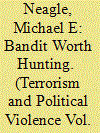

|
|
|
|
|
| Summary/Abstract |
The September 11, 2001, attacks were not the first time that a private, foreign group attacked the United States mainland. Although not referred to as an act of “terrorism” at the time, the March 1916 raid of Francisco “Pancho” Villa and his men on Columbus, New Mexico, was understood by Americans of the early-twentieth century in much the same way. The discourse of the “bandit,” as Villa was widely described at the time, connoted many of the same meanings that we ascribe to terrorists in the twenty-first century — criminality, incivility, and illegitimacy. This rhetoric served to dehumanize Villa and justified U.S. incursions on Mexican sovereignty in its fruitless pursuit of him and his militia. Moreover, Villa’s political motivations for the attack reflect a modern understanding of terrorism. He sought revenge against the Woodrow Wilson administration for withdrawing its support of him during the Mexican Revolution and tried to goad the United States and Mexico into a wider war. His brief invasion nearly succeeded in bringing about his desired result. American understandings and approaches to Villa mirror many of the same strategies that have been used in the modern war on terror.
|
|
|
|
|
|
|
|
|
|
|
|
|
|
|
|
| 6 |
ID:
182999
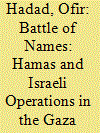

|
|
|
|
|
| Summary/Abstract |
This paper addresses the phenomenon of military operation-naming, that is, the act of giving names to war practices. Based on the four strategies of War Normalizing Discourse theory, I argue that, like nation-states, violent non-state actors also use the tool of naming to disseminate their wartime perceptions and mobilize public opinion for their own interests. Moreover, I argue that in its war-naming efforts the violent non-state actor seeks to defy and undermine the official names of its enemy state, using its own names to expand the physical battlefield to other fields of war and to present itself as an equal and legitimate player. To establish the above arguments, the article presents the case study of Hamas—specifically, the movement’s naming of rounds of fighting against Israel since the beginning of its rule in the Gaza Strip in 2007.
|
|
|
|
|
|
|
|
|
|
|
|
|
|
|
|
| 7 |
ID:
183021


|
|
|
|
|
| Summary/Abstract |
How does combat affect insurgent violence against civilians? Existing studies emphasize the role of combat outcomes, but have not explored the direct effects of various combat events. This article argues that one such event, government attacks on the rebels, has a positive effect on insurgent violence that stems from the logic of guerrilla warfare. In guerrilla wars, government forces tend to rely on informants in finding the insurgents. Their attacks therefore often evince civilian denunciation. To deter future denunciations, the rebels have incentives to subsequently punish the suspected or known denunciator. This argument is probed using detailed original data from Nepal’s Maoist insurgency. A panel analysis shows that government attacks were positively associated with rebel violence against civilians, and especially with violence against suspected informants. Process-tracing evidence further supports the argument, suggesting that the rebels used violence strategically to prevent information leaks and government attacks.
|
|
|
|
|
|
|
|
|
|
|
|
|
|
|
|
| 8 |
ID:
183002
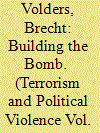

|
|
|
|
|
| Summary/Abstract |
A terrorist organization constructing and detonating a nuclear device is often a topic of popular, academic, and political concern. Yet, assessing this risk is a challenging task. This article aims to contribute to the encompassing nature of any future nuclear terrorism threat assessments by further exploring the often overlooked organizational dimension in probability assessments on nuclear terrorism. Particular emphasis is given to the role of the organizational design. In order to do so, this article theoretically builds on a 2017 research article and empirically studies Aum Shinrikyo’s chemical and biological armament activities. This article confirms and further refines the idea of an effectiveness-efficiency trade-off for a terrorist organization implementing a nuclear armament project. It particularly zooms in on the constraints that follow from the covert nature of this type of plot and elaborates on the role of Aum Shinrikyo’s value-rationality.
|
|
|
|
|
|
|
|
|
|
|
|
|
|
|
|
| 9 |
ID:
182995
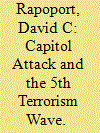

|
|
|
|
|
| Summary/Abstract |
The January 6 attack was unique in its target and potential consequences. But the methods employed were common in the 5th Wave where far-right demonstrations became common. They began against President Obama and were then encouraged by President Trump. The article examines those demonstrations, the participants, methods, and the difficulties government forces have had in dealing with them.
|
|
|
|
|
|
|
|
|
|
|
|
|
|
|
|
| 10 |
ID:
183014


|
|
|
|
|
| Summary/Abstract |
This paper uses the concept of totalism to analyze the main features of Islamic State and thus the implications of containing and confronting it and its potential future offshoots. The first part of the paper deals with the origins and concept of totalism, depicting its main features and types. This part begins by briefly showing the main features of totalism, why it must be ultimately differentiated from totalitarianism. The second part of the paper explores the extent to which Islamic State conforms to the model of a renovative totalist movement and why terms such as political religion are unsuited for explaining Islamist and Salafi-Jihadist movements, including Islamic State. Due to the overall direction of its ultimate ideological aims and the way in which it pursues the total reconstruction of public and private life, Islamic State is then found to contain the main features of a militant, renovative totalist movement. Lastly, the paper argues that it is primarily this totalist nature of the movement which, together with total commitment to emulating what it sees as the essential early Islamic traditions and examples, contributes to its long-term resilience even in the face of overwhelming odds and military reversals.
|
|
|
|
|
|
|
|
|
|
|
|
|
|
|
|
| 11 |
ID:
183034
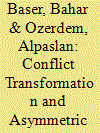

|
|
|
|
|
| Summary/Abstract |
In this article, we examine the dynamics of the Kurdish-Turkish peace process that collapsed in the summer of 2015. The negotiations began when the conflict reached a certain level of ripeness, one that made it possible for both sides to entertain the possibility of compromise on various taboo issues. However, in the face of both domestic and international developments, the process came to an abrupt halt. This article argues that the main reason the process stalled was because it was built from the start around the idea of “resolution” rather than “transformation,” a concept better suited to responding to highly fluid asymmetric conflicts.
|
|
|
|
|
|
|
|
|
|
|
|
|
|
|
|
| 12 |
ID:
182996


|
|
|
|
|
| Summary/Abstract |
While most observers classified the demonstrators called to Washington by President Trump as denizens of the far right, a closer examination of those arrested for entering the Capitol reveal a strikingly diverse group. Only a small percentage fit the description of members of the radical right. Rather, the most common thread was fealty to the President forged through adherence to QAnon and other conspiratorial beliefs.
|
|
|
|
|
|
|
|
|
|
|
|
|
|
|
|
| 13 |
ID:
183005
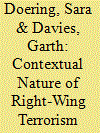

|
|
|
|
|
| Summary/Abstract |
Despite the growing threat of right-wing terrorism as a security concern in many countries, no empirical research has examined the variables that are associated with increases or decreases in right-wing terrorist incidents at a national level of aggregation. The present study examines the applicability of indicators informed by macro-level criminological theories related to immigration, economic conditions, and social demographic composition to the study of right-wing terrorism. A dataset of right-wing terrorist incidents in North America and Western Europe from 1990–2016 was created using secondary sources. Data on indicators related to socioeconomic conditions within countries were retrieved from the World Bank’s World Development Indicator database. The results show that indicators informed by criminological theory are less useful when the analyses are aggregated across countries, but provide more insight when examining relationships within individual countries. Future research should therefore take into consideration each country’s unique social, political, and economic contexts when studying terrorism at a national level.
|
|
|
|
|
|
|
|
|
|
|
|
|
|
|
|
| 14 |
ID:
183031
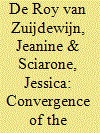

|
|
|
|
|
| Summary/Abstract |
Many European countries have been the target of jihadist terrorist attacks between 2015 and 2017. While the chance of becoming a victim of a terrorist attack is low, terrorism scholars have emphasized that terrorism does not revolve around statistics and casualty numbers. Terrorists use attacks to reach an audience and affect groups beyond the direct victims. To this date, little is known about how terrorist attacks might affect the salience of terrorism beyond national borders. This paper investigates possible convergence of issue salience of terrorism among citizens within the European Union for ten jihadist attacks in the period 2015–2017 using Eurobarometer survey data. The results indicate that it is not simply a question of convergence or divergence of salience of terrorism after a terrorist attack. The connection is multidirectional and depending upon a variety of factors. Most importantly, we observed convergence on the EU-level, but divergence on the national level. This raises important questions about the transnationality of the effects of terrorism. As this research does not test nor find a causal mechanism and is solely dependent on existing data, further research is necessary to test some of its findings.
|
|
|
|
|
|
|
|
|
|
|
|
|
|
|
|
| 15 |
ID:
183003


|
|
|
|
|
| Summary/Abstract |
This article explores the spatial and temporal diffusion of political violence in North and West Africa by endeavoring to represent a group leader's mental landscape as he contemplates strategic targeting. We assume that this representation is a combination of the physical and social geography of the target environment, and the mental and physical cost of following a seemingly random pattern of attacks. Focusing on the distance and time between attacks and taking into consideration the transaction costs that state boundaries impose, we wish to understand what constrains a group leader to attack at a location other than the one that would yield the greatest overt payoff. We leverage functional data from the Armed Conflict Location and Event Data project (ACLED) dataset that catalogs violent extremist incidents in North and West Africa since 1997 to generate a network whose nodes are administrative regions. These nodes are connected by edges of qualitatively different types: undirected edges representing geographic distance, undirected edges incorporating the costs of crossing borders, and directed edges representing consecutive attacks by the same group. We analyze the resulting network using spectral embedding techniques that are able to account fully for the different types of edges. The result is a representation of North and West Africa that depicts its empirical permeability to violence. A better understanding of how location, time, and borders condition attacks enables planning, prepositioning, and response.
|
|
|
|
|
|
|
|
|
|
|
|
|
|
|
|
| 16 |
ID:
183013
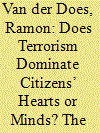

|
|
|
|
|
| Summary/Abstract |
Terrorism only poses a small risk to people but tends to be a major source of public fear. Through fear, terrorism has far-reaching implications for public governance. In this paper we look at trust in government as a potential mitigating factor of fear of terrorism. We discern between calculative trust, based on analytical assessment of previous and expected future actions, and relational trust, based on emotions and perceived value similarity with government. We find that relational trust decreases fear of terrorism. A similar but less robust negative relationship exists between calculative trust and fear. However, our regression analyses suggest that relational trust, in fact, may mediate the relationship between calculative trust and fear of terrorism. In other words, the more citizens think government is able to prevent terrorist attacks and feel that authorities are doing enough, the more they, in turn, feel that their government shares their values, and the less fearful they are of future terrorist attacks.
|
|
|
|
|
|
|
|
|
|
|
|
|
|
|
|
| 17 |
ID:
183015


|
|
|
|
|
| Summary/Abstract |
The rebound of ISIS in the online environment in the aftermath of the coalition force liberation of Mosul and Raqqa has reinvigorated the need to understand the strategic choices of the group’s media campaign. This study explores ISIS’s use of dynamic vs. static imagery, with a particular focus on how the image form helps facilitate the group’s goals. Experimental studies document that the use of dynamic imagery heightens viewer attention, recall, and reaction to visual content, while fMRI studies add that audiences process dynamic still images as imagined movements. Using a content analysis of 3745 images in Dabiq, Rumiyah, and al-Naba’ from July 2014 to September 2018, we found that ISIS relies heavily on dynamic imagery in its print media campaign. The deployment of the visual strategy, however, displays significant variation based on the language of the target audience, the primary message content displayed in the photographs, and level of military force opposition the group is facing when it disseminates magazines and newsletters.
|
|
|
|
|
|
|
|
|
|
|
|
|
|
|
|
| 18 |
ID:
183026


|
|
|
|
|
| Summary/Abstract |
Despite calls from governments to clamp down on violent extremist material in the online sphere, in the name of preventing radicalisation and therefore terrorism research investigating how people engage with extremist material online is surprisingly scarce. The current paper addresses this gap in knowledge with an online experiment. A fictional extremist webpage was designed and (student) participants chose how to engage with it. . A mortality salience prime (being primed to think of death) was also included. Mortality salience did not influence engagement with the material but the material itself may have led to disidentification with the ingroup. Whilst interaction with the material was fairly low, those that did engage tended to indicate preference for hierarchy and dominance in society, stronger identification with the ingroup, higher levels of radicalism, and outgroup hostility. More engagement with the online extremist material was also associated with increased likelihood of explicitly supporting the extremist group. These findings show that indoctrination, socialisation, and ideology are not necessarily required for individuals to engage attitudinally or behaviourally with extremist material. This study is not conducted on the dependent variable, therefore shedding light on individuals who do not engage with extremist material.
|
|
|
|
|
|
|
|
|
|
|
|
|
|
|
|
| 19 |
ID:
183025


|
|
|
|
|
| Summary/Abstract |
What leads some rebel groups to remain cohesive, while others fragment into multiple rebel groups? A growing literature examines the causes behind fragmented non-state actors and movements. Building on this work, this article examines the relationship between a rebel group and its external supporter and focuses on the extent of ethnic links between the two. It advances a novel argument for why rebel groups that receive external support from non-ethnic supporters are more likely to fragment. Using statistical analysis, I examine the relationship between ethnic and non-ethnic external support and fragmentation from 1975 to 2009. I find that an increasing percentage of co-ethnic external support is negatively associated with rebel group fragmentation. Examining variation in the relationship type that rebel groups and external supporters share provides us a fuller understanding of why some rebel groups remain cohesive and why others fragment.
|
|
|
|
|
|
|
|
|
|
|
|
|
|
|
|
| 20 |
ID:
183030


|
|
|
|
|
| Summary/Abstract |
This article evaluates the political dynamics of the 2014 presidential election to explore the sense of nationhood that could have formed in post-2001 Afghanistan and to gauge its strength. It examines frontrunner candidates – Mohammad Ashraf Ghani and Abdullah Abdullah’s – campaign rhetoric and processes they utilized to manipulate ethnic identities for political ends. Ethnic identities sharpened by ideological and political polarisation during the civil war (1978–2001), continue to play a critical part in the political economy dynamics of post-2001 era. With the popular patriotic idea of citizenship remaining weak, the abundance of ethnic identities provides a paradigm around which power contenders articulate messages that easily feed into popular perceptions of “us” and “other”. The article contextualizes representative and consociational democracy exploring whether these models of democracy offer any solution to social cleavages in Afghanistan. It argues that elites’ manipulation of ethnic identities and distribution of resources through ethnic shares (Bonn Conference 2001, National Unity Government (NUG) 2014) might reinforce ethnic boundaries, leading to deeper consolidation of ethnic divisions.
|
|
|
|
|
|
|
|
|
|
|
|
|
|
|
|
|
|
|
|
|